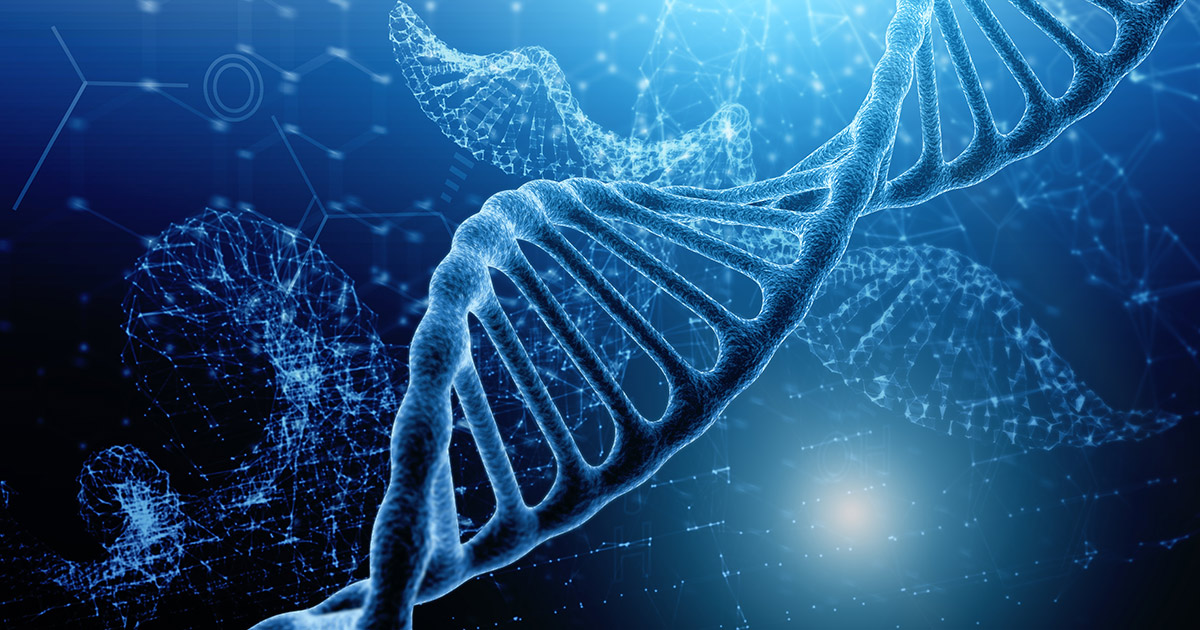Attention
The opinions expressed in this text may not coincide with the views of the official medicine.
They do not replace in any way the opinion of any attending physician.
The author assumes no responsibility for improper use of the information contained in the text.
Dr. Armando Vecchietti – www.cellulacancerosa.it
Modern oncology hypothesizes that cancer develops because of viral, biochemical, genetic causes, or because of a deterioration of the immune mechanisms.
Many researchers believe that a vaccine will soon be found or that stem cells will solve the problem.
For some time there has also been some talking about “smart” drugs or personalized therapies.
However, all research hypotheses have failed to meet expectations and cancer still remains a mystery.
After more than fifty years of research and millions of dollars spent, what is really important about cancer can be summarized on half a notebook page.
Despite this, almost all oncologists flaunt casual confidence in public, speak of very high cure rates and affirm that cancer will soon be definitively defeated.
In fact, cancer patients have no real weapon at their disposal and much of their suffering is due more to the treatments than to the disease itself.
For official oncology, tumor and cancerous cells are the disease.
For this reason, the cure still consists in the surgical removal of the tumoral mass or in the attempt to destroy the cancerous cells with radiation or chemicals.
In other words, the cancer cell is still considered the sole target of therapeutic intervention, due to the mechanistic premise that it is the cause of the disease.
Therefore, explaining how cancer really works becomes fundamental for its understanding and for a serious therapeutic approach.
The two phases of the cancerous process

Cancer develops by going through two equal and opposite phases.
- In the first phase, all those modifications take place, they lead the biological tissues to vesicularly disintegrate with the consequent reorganization of the vesicles themselves and the subsequent birth of cancerous cells.
- In the second phase the reverse process takes place, i.e. the death of the cancer cells that make up the tumor mass and their putrid decomposition inside the body.
While, during the first phase, the patient lives with the disease for years, sometimes without even realizing he has it, the second phase is much shorter and leads the patient to death in a few weeks. Below we will briefly see how this all happens.
The enigma of the cancerous cell

One of the unsolved mysteries of cancer is surely how cancerous cells are formed.
According to classical oncological research, the cancerous cell originates from an anomalous genetic mutation in the DNA of a healthy cell.
In fact, it is generally believed that when cancer develops, one or more healthy cells, previously calm, begin to “agitate”.
These cells begin to divide rapidly by implementing a vigorous proliferation, forming the actual tumoral mass shortly thereafter. Cancerous cells, unlike healthy cells, can move and have the ability to infiltrate surrounding tissues.
How is it possible that a still healthy cell, that lives and functions in harmony with all the other healthy cells, starts to differ from them, acquires motility and becomes “wild”, managing to destroy an otherwise healthy organism?
Knowing that from a vital point of view the cancerous cell is a much weaker structure than a normal healthy cell and can be destroyed easily, this seems quite strange.
How can this happen?
Up to now, the traditional oncological research has not been able to give a satisfactory answer and in fact still knows absolutely nothing certain about what really happens between the state of health and that of disease.
On the other hand, Orgonomy knows that a series of processes take place in the cells and in the tissues involved, which herald and precede the actual cancerous cell well in advance.
We will soon see how the cancerous cell and the subsequent malignant tumor represent only the most visible manifestation of the disease.
If the “fight” against cancer has not made real progress, this is due to the belief that local tumor has continued to be considered as the real disease, ignoring instead that cancer is a global disease that affects the whole body.
We have said that the fully developed cancerous cell is actually the end product of a long series of processes that take place in the affected tissues.
During its formation, typical phases are passed through which are absolutely absent in healthy cells and tissues and which can be summarized as follows:
a) Formation of vesicles inside the cells (Vesicular Disruption)
Observing living and healthy cells with an optical microscope, they have a substantially “clean” appearance.
Normally a cell membrane is recognized while delimiting an internal space (cytoplasm) within which a nucleus floats and at a magnification of 300x no other organelles are noticed inside (picture 1).

In biological tissues that are sliding towards an oncological pathology, observing in vivo, the same cells appear in a very different way, showing an intense presence of vesicles inside them.
The loss of the normal structure of the cells through the formation of vesicles becomes the first signal of the possible beginning of a cancerous degeneration (picture 2).
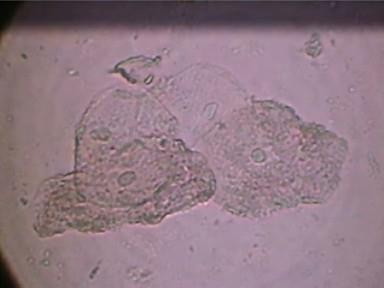
Picture 2
b) Aggregation, fusion and re-organization of these vesicles into new structures.
The vesicles, which were initially homogeneously distributed within the cell, now aggregate and fuse together to form a new structure (pictures 3a-b-c).
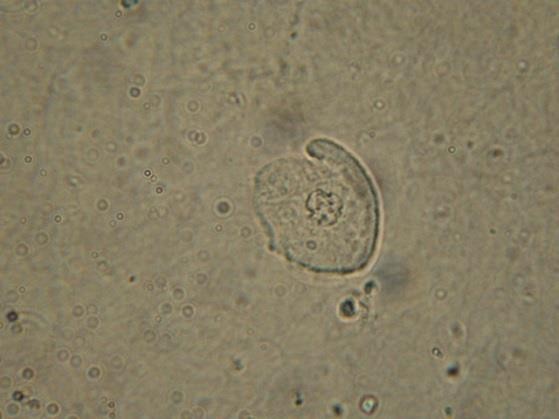
Picture 3a
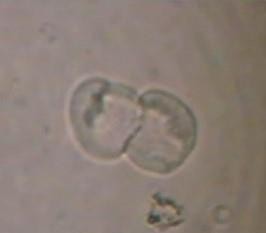
Picture 3b
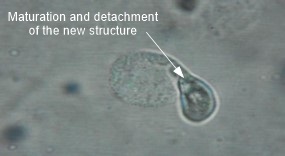
Picture 3c
Over time, all these new formations produce a membrane and they tend to detach themselves.
c) Transformation and evolution into club-like structures, first motionless and in motion.
Therefore, the next stage is the detachment of these new formations.
Once free, they furhre mature by lengthening and assuming a more evolved club shape.
It is important to note that in humans, no biological tissue is formed by cells with this shape.
In fact, we are faced with a new cell that we can define as pre-tumoral one.
This form is typical and unique. Usually its presence precedes the formation of the tumoral mass.
As we will see shortly, this particular characteristic, and its easy identification in vivo with a simple microscopic examination, makes it very useful and of fundamental importance for a very early diagnosis.
The presence of this type of cell, combined with the presence of other figures, unequivocally denounce a cancerous process. It must be said that at this stage, official oncology, with its own tests, still does not identify any presence of cancerous cells or type of tumor and therefore there is no disease (pictures 4a-b-c-d-e-f-g-h-i).
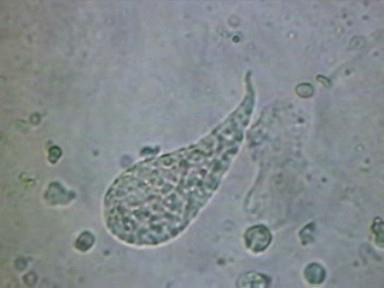
Picture 4a
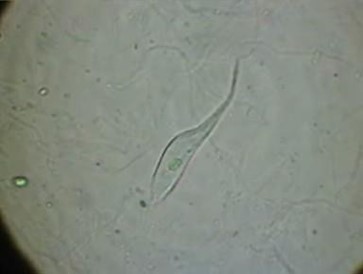
Picture 4b
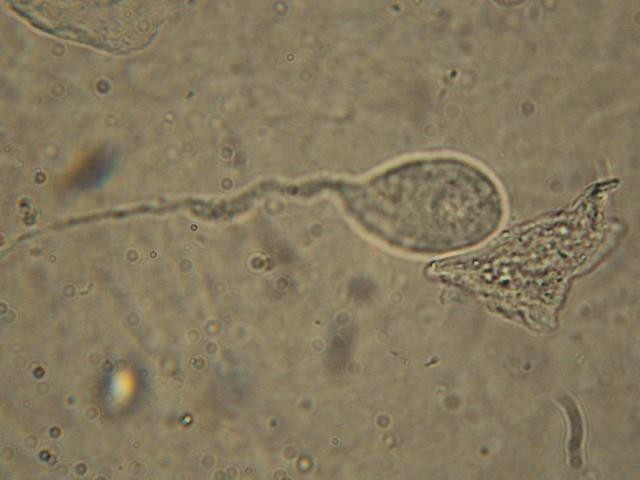
Picture 4c
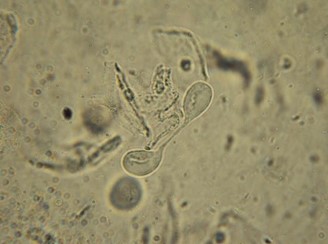
Picture 4d
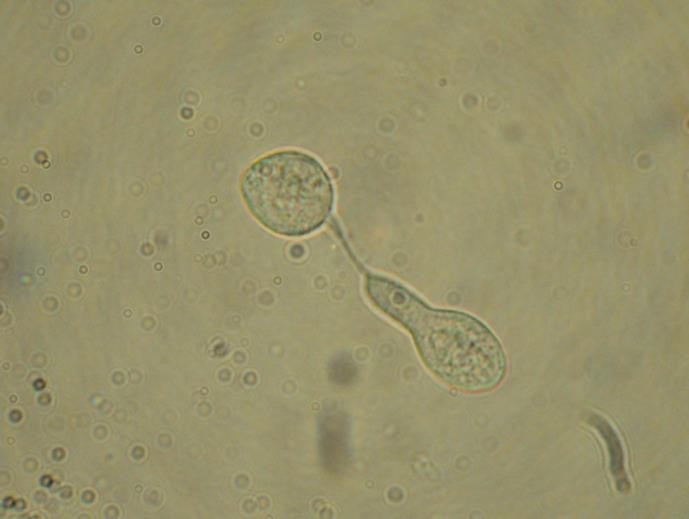
Picture 4e
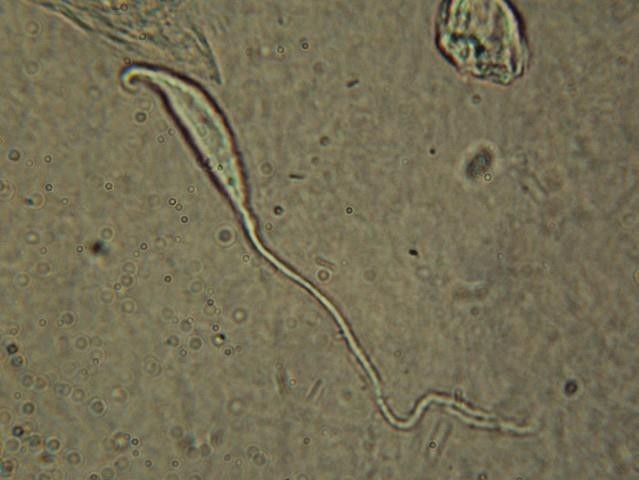
Picture 4f
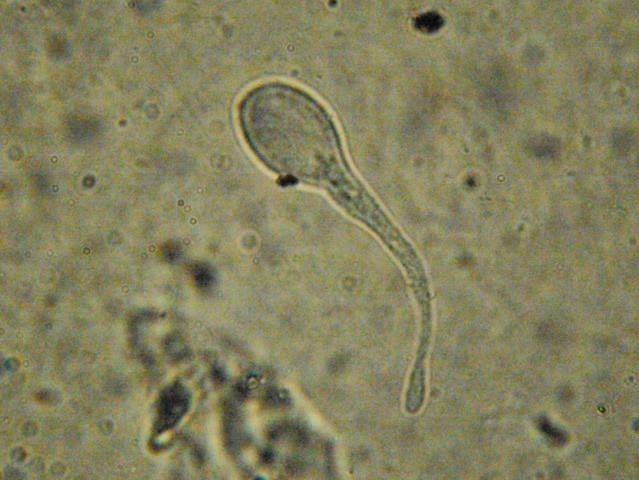
Picture 4g
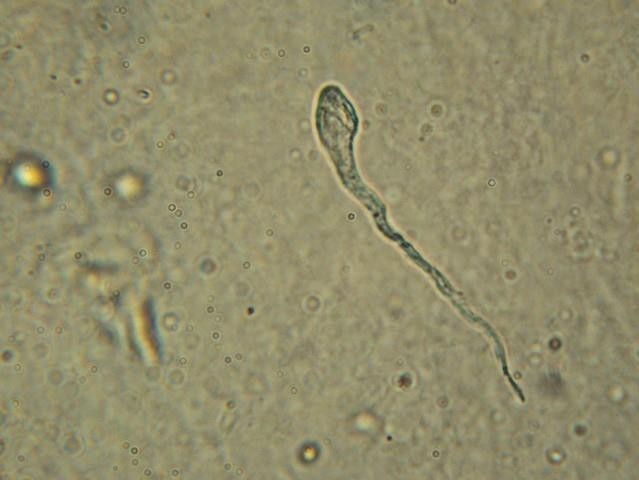
Picture 4h
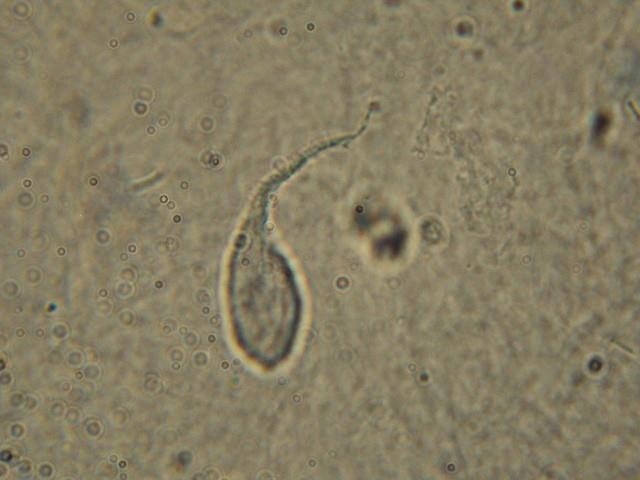
Picture 4i
d) Consequent development of mobile cells similar to floating amoebae.
In the final stage of the disease, the cancerous cells mature into motile single-celled organisms of various sizes and shapes (picture 5).
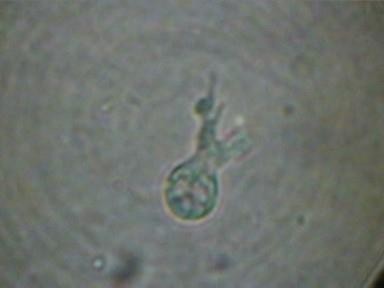
Picture 5
Decomposing cancerous tissue is always putrescent and the final product is always made up of an extraordinary quantity of micro-organisms which Reich called T bacilli.
They interest us for only one important biological function: they attack healthy cells causing them to vesicularly disintegrate. In in this way they close the circle.
The T bacilli constitute the real serious problem of cancer and the real serious danger to the body.
- The greater the number of dead cancer cells, the more T-toxicity will result from their decomposition.
- The greater the T intoxication, the greater the number of healthy cells attacked and induced to produce the vesicular bionic reaction.
- The greater the vesicular bionic reaction, the greater the formation of new cancerous cells will be, starting a new cycle and the vicious circle that will lead the patient to death.
Si intuisce allora che una buona terapia oncologica non dovrebbe risiedere nella diretta distruzione del tumore o delle cellule cancerose.
It is therefore understood that a good oncological therapy should not reside in the direct destruction of the tumor or of the cancerous cells.
The direct action against the tumoral mass, or the killing of cancerous cells, leads to the anticipated production of billions of small, new cadavers (the killed cells) which will putrefy in advance, producing T bacilli inside an already weak and tried body.
A real therapy, on the contrary, should expel the products of putrefaction and decomposition from the body as quickly as possible and in the most radical way instead of generating new ones.
The body’s ability to self-clean is given by the energy state of the organism itself and it is possible to grasp it with two simple tests that are performed on the blood.
It must be said that a bio-energetically depleted organism can produce T corpuscles even from simple traumatic tissue injuries. Therefore it can happen that even simple burns or wounds can produce T bacilli.
If the involved tissue is large, as for example in extensive and deep burns, if the cells involved in the lesion are energetically discharged, they putrefy and produce enormous quantities of T bacilli.
In an energy-depleted organism, the first T bacilli resulting from these first traumatic lesions can already begin to strike the first weaker “healthy” cells, stimulating their vesicular reaction, thus triggering the cancerous process.
Vesicular formation and reorganization will produce the first cancerous cells.
The formation of tumors from damage caused by a dental prosthesis is also a standard.
In these cases, what matters is not the local damage to the tissue as is mistakenly thought, but the starting energy charge of the organism and of the damaged cells.
It would be appropriate for medicine to understand that the agent and the specific pathological cause become active only when the organism allows it.
The first real step in the development of a malignant tumor is therefore not the vesicular reaction of the “healthy” cells or of the cancerous cell, but the quantity of T corpuscles present in the tissues which are able to trigger the vesicular process by hitting cells with a low energy charge.
Let’s see how the process happens.
T bacilli can also be found in healthy organisms and this may seem counterintuitive.
It must therefore be explained that the healthy organism does not differ from the cancerous one by the absence of T corpuscles but by its energy charge, i.e. by the ability to keep them in check and by the low availability of its tissues to disintegrate in them.
The tendency to cancer is therefore a universal and continuous fact. It follows that there is no real carcinogenic element.
As long as the organism is strong, each T bacillus, generated by the various “carcinogens”, is annihilated and made harmless.
The susceptibility to cancer can therefore be determined with energetic tests and not with biochemical tests.
This is possible by observing the biological resistance of blood and tissues to putrefaction which in turn is determined by the energy charge and power of the organism (it is on this assumption that Wilhelm Reich’s blood tests for the early diagnosis of cancer are based).
The cancerous process

What happens in the tissues when the T infection is too strong and the body’s vesicular reaction is too weak?
The aggression of the T infection stimulates in a completely natural way the reaction of the energetically weaker cells which start to produce vesicles to defend themselves (the details of this behavior will be explained in another context).
The more the attacked cells are discharged, the more they compensate for their weakness with increased vesicle production.
When the cell is depleted of energy, the vesicles that are formed are therefore smaller but more numerous.
The crowding of these vesicles favors their natural ability to aggregate until they become our known cancerous cells as described in the various steps of the previous pages.
If these vesicles did not have the natural predisposition to aggregate, the cancerous cell would most likely not exist.
In itself, vesicular aggregation and subsequent evolution is not a pathological phenomenon but a natural and spontaneous behavior.
This behavior cannot be chemically or pharmacologically modified, as it is an energetic process.
It is then understood that cancer cells are not born or are not formed as carriers of disease. They are not the direct cause of cancer but a spontaneous and completely secondary product.
They derive from the natural and spontaneous reorganization of the vesicles which are formed by the vesicular disintegration of energetically depleted cells when they are attacked by T bacilli.
The pathogenicity of cancer therefore does not reside in the cancerous cell itself.
We said above that the cancerous process takes place in two opposite phases.
We have also seen how the first phase is characterized by:
- Production of T corpuscles from bio-energetically weaker cells.
- Vesicular reaction as a defensive reaction of cells.
- Natural reorganization of vesicles into cancerous cells.
- Tumoral mass formation.
All this is followed by a second more important and inverse phase to the previous one.
- It begins with the death of cancerous cells that have completed their life cycle and their subsequent putrefaction within the body (tumoralt mass necrosis).
- The result is a continuous, massive, progressive and accelerated intoxication of the blood by T bacilli and putrefaction bacteria.
- It ends with cachexia and generalized putrefaction of the whole organism and the consequent death.
Having reached the end of their life cycle, the now mature cancerous cells die, putrefy and decompose into T bacilli producing a more intense putrefaction of the blood and the tissues with a generalized and total intoxication.
The death of the patient is not attributable to the living cancerous cells but to the putrefaction of the dead ones and the subsequent production of T bacilli.
If, at the onset of the disease, the formation of the first cancerous cells causes locally limited damage, the subsequent death of the make up the tumoral mass is instead the cause of the gigantic accelerated putrefaction of the whole body.
It is for this reason that at first the cancer patient seems to respond well to traditional therapies but then collapses almost suddenly annihilated by a galloping cachexia which leads him to death in a short time.
In contrast to the first phase which can last up to years, the second phase lasts only a few weeks.
The formation of T-bacilli and the putrefaction of cancerous cells are therefore cause and effect of the cancerous process. This aspect is of enormous importance for therapeutic purposes.
When the tumour, the tissues and the blood are in the putrid decomposition stage (Ca5), such a large quantity of T bacilli is formed as to make useless any therapy.
Conclusioni

- The cancerous cell is not formed as a carrier of disease or death but as a secondary product and as a defense reaction of the organism.
- The cancerous cell is not the cause of cancer but the consequence.
- Therapies that kill the cancerous cell are therefore useless, indeed harmful, since they act on the consequence and not on the cause.
- All known types of cancer have only one origin and are in fact one and the same disease as the precursors of cancerous cells are the same for all types of solid tumors.
- The real problem for the cancer patient lies not in the living cancerous cell, but in the putrefaction of the dead one.
- The tendency to cancer is a universal fact, there is no real carcinogen element.
- The observation of the vesicular reaction of the cells, their reaggregation and evolution in the precursors of cancerous cells allows us a much earlier diagnosis that anticipates by many years the common tests in use today in oncology
More information on the topics covered can be found at:
I am Dr. Armando Vecchietti,
I live in Civitanova Marche in the province of Macerata, Italy, and work in my own analysis laboratory in Appignano.
I studied Biological Sciences in Camerino where I graduated in 1977.
I met Reich and orgonomy for the first time in 1972 with the book “The Biopathy of Cancer”.
I was so fascinated and struck by those discoveries that I was prompted to study them more thoroughly by repeating numerous orgonomic experiments.
It is in this way that I approached and then became interested in cancer, first by studying the cancerous cell from an orgonomic point of view, then by verifying and confirming Reich’s entire orgonomic approach.
After the military break, I started working again, this time in my clinical chemistry laboratory which I had opened in the meantime.
In my work, the large quantity and ease with which I could find biological material made it easier for me to verify the numerous and ingenious observations made by Reich on cancer patients.
It is therefore in this environment that for over 20 years, with this great availability of biological material, my orgonomic preparation research has developed and still continues.
Global exposure was instead facilitated by the advent of digital technology and the nascent Internet.
The latter has put me in a position to show the whole world my work which today is summarized on the website www.cellulacancerosa.it and on my YouTube channel.
From this window on the world, important contacts were born which led me to be known and appreciated by an ever-increasing number of people and medical researchers. I have been a speaker at dozens of conferences both in Italy and abroad and others are already planned. Very interesting and very scientifically complete, it was an interview of mine for a television station in northern Italy which I recommend watching and I am attaching the link: https://youtu.be/I0nQLkt0kt0
I have also published articles from my orgonomic research on:
– Science and Knowledge issue no.35, February 2011 (publication of the article: Cancer and orgonomy: Reich’s Legacy), another article appeared in issue no. 70, 2019.
Sites that host online, in full or in part, excerpts from my research are now numerous on the web. Currently I am among the very few professionals in Europe to perform energy tests according to orgonomic directives, also receiving contacts from abroad for clarifications or advice. In 2007 I founded a non-profit organization with the name Co.Ri.Org, or COnsulenze e RIcerche ORGonomiche, with which we aim to spread orgonomy and at the same time to deal with classical oncology in order to make it more visible, transparent and legal the relationship with it. In 2013 I was one of the organizers and speakers of the First World Congress of Orgonomy which was held in Rome with the participation of researchers from different parts of the world.
Corridonia, 28 February 2023
Armando Vecchietti

